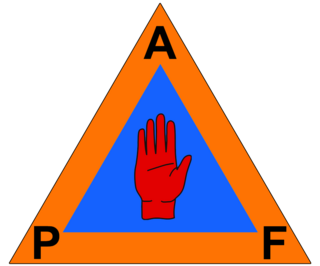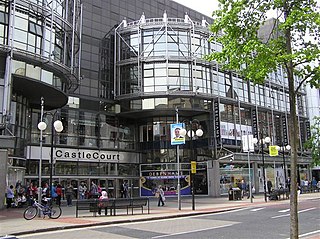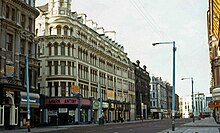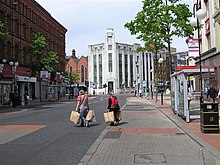Bloody Friday is the name given to the bombings by the Provisional Irish Republican Army (IRA) in Belfast, Northern Ireland on 21 July 1972, during the Troubles. At least twenty bombs exploded in the space of eighty minutes, most within a half-hour period. Most of them were car bombs and most targeted infrastructure, especially the transport network. Nine people were killed: five civilians, two British soldiers, a Royal Ulster Constabulary (RUC) reservist, and an Ulster Defence Association (UDA) member, while 130 were injured. The IRA said it sent telephoned warnings at least thirty minutes before each explosion and said that the security forces wilfully ignored some of the warnings for their own ends. The security forces said that was not the case and said they were overstretched by the sheer number of bombs and bomb warnings, some of which were hoaxes.

The Irish People's Liberation Organisation was a small Irish socialist republican paramilitary organisation formed in 1986 by disaffected and expelled members of the Irish National Liberation Army (INLA), whose factions coalesced in the aftermath of the supergrass trials. It developed a reputation for intra-republican and sectarian violence as well as criminality, before being forcibly disbanded by the Provisional Irish Republican Army (IRA) in 1992.

The Falls Road is the main road through West Belfast, Northern Ireland, running from Divis Street in Belfast City Centre to Andersonstown in the suburbs. The name has been synonymous for at least a century and a half with the Catholic community in the city. The road is usually referred to as the Falls Road, rather than as Falls Road. It is known in Irish as the Bóthar na bhFál and as the Faas Raa in Ulster-Scots.
Belfast City Centre is the central business district of Belfast, Northern Ireland.
This is a chronology of activities by the Provisional Irish Republican Army (IRA) from 1970 to 1979.

The Donegall Road is a residential area and road traffic thoroughfare that runs from Shaftesbury Square on what was once called the "Golden Mile" to the Falls Road in west Belfast. The road is bisected by the Westlink – M1 motorway. The largest section of the road, east of the Broadway junction with the Westlink, has a community which self-identifies as predominantly Protestant while the community on the other side of the Westlink – M1 motorway self-identifies as predominantly Catholic.

The Protestant Action Force (PAF) was a front group used by Ulster loyalist paramilitaries in Northern Ireland when claiming responsibility for a number of attacks during the Troubles. First used in 1974, attacks by individuals claiming to be members of the PAF killed at least 41 Catholic civilians. The PAF was most commonly used by members of the Ulster Volunteer Force (UVF). All of the attacks claimed by the PAF in Armagh and Tyrone counties from 1974 to 1976 have been linked to the Glenanne gang, which was a group consisting of members of the UVF Mid-Ulster Brigade along with rogue Ulster Defence Regiment (UDR) soldiers and Royal Ulster Constabulary (RUC) police officers. A six-year period of no attacks claimed by the PAF ended in 1982; during the 1980s, the PAF claimed 15 attacks in the Belfast area and two in County Armagh. UDR soldiers were convicted of two attacks in Armagh. The PAF claimed its last attacks in the early 1990s, all of which were in north Armagh and were alleged to involve members of the security forces.

CastleCourt is a shopping centre on Royal Avenue in Belfast, Northern Ireland. It is Northern Ireland's third largest shopping centre after Victoria Square and Foyleside in Derry. As of 2007, it had approximately 16 million visits a year, and sale densities ranked in the top 10% in the UK.
Smithfield and Union is one of the Belfast quarters established by Belfast City Council in the 21st century. Initially designated the Smithfield Market and Library quarter, the current name was adopted in 2011. Based around the north of Belfast City Centre it extends from North Street to Frederick Street and is bounded by Royal Avenue/York Street and Carrick Hill/Millfield. It houses Belfast Central Library and two of the main daily newspapers The Irish News and The Belfast Telegraph.
This is a timeline of actions by the Irish National Liberation Army (INLA), an Irish republican socialist paramilitary group. Most of these actions took place as part of its 1975–1998 campaign during "the Troubles" in Northern Ireland. The INLA did not start claiming responsibility for its actions under the INLA name until January 1976 at which point they had already killed 12 people, before then they used the names People's Liberation Army (PLA) and People's Republican Army (PRA) to claim its attacks.
This is a timeline of actions by the Ulster Volunteer Force (UVF), an Ulster loyalist paramilitary group since 1966. It includes actions carried out by the Red Hand Commando (RHC), a group integrated into the UVF shortly after their formation in 1972. It also includes attacks claimed by the Protestant Action Force (PAF), a covername used by the UVF. Most of these actions took place during the conflict known as "the Troubles" in Northern Ireland.
This is a chronology of activities by the Provisional Irish Republican Army (IRA) from 1980 to 1989. For actions before and after this period see Chronology of Provisional Irish Republican Army actions.
This is a chronology of activities by the Provisional Irish Republican Army (IRA), from 1992 to 1999.

The Donegall Street bombing took place in Belfast, Northern Ireland on 20 March 1972 when, just before noon, the Provisional IRA detonated a car bomb in Lower Donegall Street in the city centre when the street was crowded with shoppers, office workers, and many schoolchildren.
Between 26 November 1972 and 20 January 1973, there were four paramilitary bombings in the centre of Dublin, Ireland. Three civilians were killed and 185 people were injured. No group ever claimed responsibility for the attacks and nobody was ever charged in connection with the bombings. The first bombing in Burgh Quay may have been carried out by former associates of the Littlejohn brothers who were Secret Intelligence Service provocateurs, in a successful attempt to provoke an Irish government clampdown against the Provisional IRA, while the other three bombings were possibly perpetrated by loyalist paramilitaries, specifically the Ulster Volunteer Force (UVF), with British military or intelligence assistance. The UVF claimed in 1993 to have carried out the 1974 Dublin and Monaghan bombings which incurred the greatest loss of life in a single day throughout the 30-year conflict known as the Troubles.

The Springfield Road is a residential area and road traffic thoroughfare adjacent to the Falls Road in west Belfast. The local population is predominantly Irish nationalist and republican. Along parts of the road are several interface area with the neighbouring Ulster loyalist areas of the Greater Shankill. The Springfield Road includes the Ballymurphy and New Barnsley districts and is overlooked by Black Mountain and Divis.
The Antrim Road is a major arterial route and area of housing and commerce that runs from inner city north Belfast to Dunadry, passing through Newtownabbey and Templepatrick. It forms part of the A6 road, a traffic route which links Belfast to Derry. It passes through the New Lodge, Newington and Glengormley areas of Northern Ireland amongst others.

Great Victoria Street in Belfast, Northern Ireland, is a major thoroughfare located in the city centre and is one of the important streets used by pedestrians alighting from Belfast Great Victoria Street railway station and walking into shopping streets such as Royal Avenue.
This is a chronology of activities by the Provisional Irish Republican Army (IRA), in 1990 and 1991.













